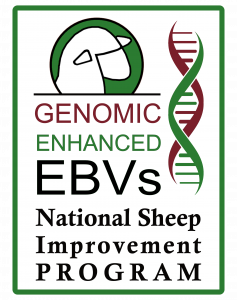WHAT IS NSIP?

Some Katahdin sheep producers participate in the National Sheep Improvement Program, (NSIP). It is a program developed to help determine genetic evaluation through performance records to predict economically important traits. Those traits are referred to as Estimated Breeding Values or EBVs. Those traits are referred to as Estimated Breeding Values or EBVs. They are measurements of economically important traits that are heritable such as growth, milk production, prolificacy, mothering ability and parasite resistance. An EBV is a predictor of the genetic merit of the individual animal itself. The use of EBVs along with visual appraisal help us stay focused on an animal that not only looks good, but is also of increasing genetic values as well.
“EBVs are science-based, industry-tested measurements of heritable traits that can be tracked and measured. For those familiar with Expected Progeny Differences (EPDs) used in cattle, EBVs are very similar. EPDs denotes the breeding value of an individual animal’s progeny whereas EBVs denote the value of the individual animal. More simply, EBVs equal EPDs times two.”
TRAITS TRACKED IN KATAHDIN SHEEP WITHIN NSIP WITH EBVS
- (BWT) Birthweight
- (WWT) Weaning Weight
- (YWT) Yearling Weight
- (PFEC) Postweaning Fecal Egg Count
- (PFAT) Postweaning Fat Depth
- (NLW) Number of Lambs Weaned
- (MWWT) Maternal Weaning Weight
- (PWWT) Postweaning Weight
- (WFEC) Weaning Fecal Egg Count
- (PEMD) Postweaning Loin Muscle Depth
- (NLB) Number of Lambs Born
- USA Hair Index
What are EBV's
How are EBV's Used?
Estimated Breeding Values, often referred to simply as EBVs, are measurements of certain economically-important heritable traits. Based on data collected on participating farms, EBVs are a measure of an individual animal’s performance, but also incorporate performance of related animals in that same flock, as well as related animals in other participating flocks. Scientifically based, EBVs have been tested in several breeds in a wide array of management systems across the U.S. sheep industry. The use of EBVs has been demonstrated to enhance economically-important decisions over visual appraisal alone.
The Katahdin breed is leading the sheep industry with the addition of genomic data to increase accuracies of EBV’s in NSIP Katahdin sheep. 20 years from now they will consider what the Katahdin breed did for the sheep industry as revolutionary for the benefit of all sheep breeds.
Some producers of purebred breeding stock use EBVs to identify the superior animals in their flocks. With that information in hand, they can breed the best to the best and improve certain traits. This can rapidly accelerate genetic progress in their flock and ultimately in the breed. In addition to specific EBVs, certain traits have been combined (i.e., indexes) to facilitate selecting breeding stock that is better suited to particular environmental or management situations. Using EBVs, however, is not limited to producers of breeding stock, operators of commercial flocks know well what traits are important to their bottom line and can use EBVs to select superior replacement ewes or new sires with the genetics they need.
We utilize NSIP data as one of the selectin criteria in our rams that we use for genetic improvement.
